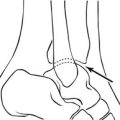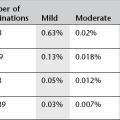Reproductive system
Akin, O, Mironov, S, Pandit-Taskar, N, et al. Imaging of uterine cancer. Radiol Clin North Am. 2007; 45(1):167–182.
Barakat, RR, Hricak, H. What do we expect from imaging. Radiol Clin North Am. 2002; 40(3):521–526.
Fütterer, JJ, Heijmink, SW, Spermon, JR. Imaging the male reproductive tract: current trends and future directions. Radiol Clin North Am. 2008; 46(1):133–147.
Hedgire, SS, Pargaonkar, VK, Elmi, A, et al. Male pelvic imaging. Radiol Clin North Am. 2012; 50(6):1015–1226.
Hysterosalpingography
Equipment
Patient preparation
1. The patient should abstain from intercourse between booking the appointment and the time of the examination, unless she uses a reliable method of contraception and the appointment is made before day 21, or the examination can be booked between the 4th and 10th days in a patient with a regular 28-day cycle.
Technique
1. The patient lies supine on the table with knees flexed, legs abducted.
2. The vulva can be cleaned with chlorhexidine or saline. A disposable speculum is then placed using sterile jelly and the cervix is exposed.
3. The cervical os is identified using a bright light and the HSG catheter is inserted into the cervical canal. It is usually not necessary to use a Vulsellum forceps to hold the cervix with a forceps, but occasionally this may be necessary. The catheter should be left within the lower cervical canal if cervical incompetence is suspected.
4. Care must be taken to expel all air bubbles from the syringe and cannula, as these would otherwise cause confusion in interpretation. Contrast medium is injected slowly into the uterine cavity under intermittent fluoroscopic observation.
5. Spasm of the uterine cornu may be relieved by intravenous (i.v.) glucagon if there is no tubal spill bilaterally.
N.B. Opiates increase pain by stimulating smooth muscle contraction.
Aftercare
1. It must be ensured that the patient is in no serious discomfort nor has significant bleeding before she leaves.
2. The patient must be advised that she may have spotting or occasionally bleeding per vagina for 1–2 days and pain which may persist for up to 2 weeks.
3. Prophylactic antibiotics are routinely given in several centres and is good practice.
Complications
Due to the contrast medium
Allergic phenomena – especially if contrast medium is forced into the circulation.
Due to the technique
1. Pain may occur at the following times:
(b) During insertion of the cannula or inflation of balloon, some patients may have develop vasovagal syncope – ‘cervical shock’
(c) With tubal distension proximal to a block
(d) With distension of the uterus if there is tubal spasm
(e) With peritoneal irritation during the following day, and up to 2 weeks.
2. Bleeding from trauma to the uterus or cervix
3. Transient nausea, vomiting and headache
4. Intravasation of contrast medium into the venous system of the uterus results in a fine lace-like pattern within the uterine wall. When more extensive, intravasation outlines larger veins. It is of little significance when water-soluble contrast medium is used. Intravasation may be precipitated by: direct trauma to the endometrium, timing of the procedure near to menstruation or curettage, tubal occlusion or congenital abnormalities
5. Infection – which may be delayed. Occurs in up to 2% of patients and is more likely when there is a previous history of pelvic infection.
Ultrasound of the female reproductive system
This can be performed transabdominal (TA) and/or transvaginal (TV).
Reporting gynaecological ultrasound
The following format may be useful to assess the female reproductive system:
1. Uterine size in three dimensions, note on any congenital anomalies, presence of fibroids (include size and location) or adenomyosis
2. Three-dimensional ovarian measurements and volume. Presence of features including polycystic ovaries, significant cysts or mass lesions. Colour Doppler is useful in the assessment of complex adnexal mass lesions helping to differentiate retracted clot from solid components with blood supply
3. Comment on adnexae for extra-ovarian lesions
4. Examine the cul-de-sac for presence of endometriotic deposits or mass lesions. Note presence of free fluid or ascites.
Several software enhancements are available to improve resolution. Tissue harmonic imaging is useful for interrogation of difficult patients. 3D and 4D ultrasound are also currently widely available and mainly used in obstetric imaging. In gynaecology, 3D endometrial imaging may be useful, but generally adds little clinical value.
Contrast medium
Galactose monosaccharide microparticles (Echovist) were used as a specific contrast agent in the assessment of tubal patency; spillage of the microparticles into the peritoneal cavity infers patency. However, this product has been withdrawn recently. Sonovue (sulphur hexafluoride microbubbles) is not currently licensed for intrafallopian use.2 Hence fluoroscopic hysterosalpingography remains the most reliable and safe investigation currently.
Ascher, SM, Reinhold, C. Imaging of cancer of the endometrium. Radiol Clin North Am. 2002; 40(3):563–576.
Bates, J. Practical Gynaecological Ultrasound, 2nd ed. Cambridge: Cambridge University Press; 2006.
Bhatt, S, Ghazale, H, Dogra, VS. Sonographic evaluation of ectopic pregnancy. Radiol Clin North Am. 2007; 45(3):549–560.
Funt, SA, Hann, LE. Detection and characterization of adnexal masses. Radiol Clin North Am. 2002; 40(3):591–608.
Ultrasound of the scrotum
Indications
1. Suspected testicular tumour
2. Suspected epididymo-orchitis
4. Acute torsion. In boys or young men in whom this clinical diagnosis has been made and emergency surgical exploration is planned, US should not delay the operation. Although colour Doppler may show an absence of vessels in the ischaemic testis, it is possible that partial untwisting resulting in some blood flow could lead to a false-negative examination
Technique
1. Secure environment with patient privacy protected.
2. Patient supine with legs together. Some operators support the scrotum on a towel draped beneath it or in a gloved hand.
3. Both sides are examined with longitudinal and transverse scans enabling comparison to be made.
4. Real-time scanning enables the optimal oblique planes to be examined.
5. In comparing the ‘normal’ with the ‘abnormal’ side, the machine settings should be optimized for the normal side, especially for colour Doppler. They should not be changed until both sides have been compared using the same image settings.
6. Patient should also be scanned standing upright and a Valsalva manoeuvre can be performed if a varicocele is suspected.
7. Testicular size and volume, echogenicity and presence of focal lesions to be noted. Epididymes are seen posterolaterally. Presence of cysts and inflammatory changes needs to be noted. Also look for hydrocele evident as free fluid outside the testes in the tunica.
Magnetic resonance imaging of the reproductive system
Indications
1. Staging of cervical and endometrial cancer
2. Characterization of complex ovarian mass
3. Suspected Müllerian tract anomalies
4. Investigation of endometriosis
5. Staging of ovarian cancer (although CT is often necessary)
7. Scrotal MR can be used, generally after US, to further characterize a mass as intra- or extra-testicular and to determine the location of intra-abdominal undescended testis
8. Localization and morphology of uterine fibroids prior to consideration for uterine artery embolization.
Gynaecological malignancy
There are two commonly used staging systems for gynaecological cancers, namely Fédération Internationale de Gynécologie et d’Obstétrique (FIGO) and TNM; the former is recommended for use in current UK practice.1
Cervical cancer
MRI sequences
1. Axial T1W – whole pelvis (slice thickness 5–7 mm)
2. Axial, coronal and sagittal T2W high resolution (3-mm slices).
Use of intravenous Buscopan or the other antiperistaltic agent may be useful to reduce artefacts from bowel movements.
Additional sequences may be necessary and be varied according to local protocol.
Uterine carcinoma
MRI staging
1. Axial and sagittal high-resolution 3-mm slices with small FOV
2. Axial T2 whole pelvis 5 mm thickness
3. Axial T1W whole pelvis 5–7 mm thickness
4. T1W fat-saturated GRE sagittal and axial dynamic at 30, 60 and 180 s post-i.v. gadolinium
5. Diffusion-weighted imaging may improve the overall staging accuracy.
Lewin, SN. Revised FIGO staging system for endometrial cancer. Clin Obstet Gynecol. 2011; 54(2):215–218.
Pecorelli, S. Revised FIGO staging for carcinoma of the vulva, cervix and endometrium. Int J Gynecol Obstet. 2009; 105(2):103–104.
Pecorelli, S, Zigliani, L, Odicino, F, et al. Revised FIGO staging for carcinoma of the cervix. Int J Gynaecol Obstet. 2009; 105(2):107–108.
Omental biopsy
Patient preparation
Written consent should be obtained. Risk of bleeding and injury to bowel should be explained.
Brown, MA, Martin, DR, Semelka, R. Future directions in MR imaging of the female pelvis. Magn Reson Imaging Clin N Am. 2006; 14(4):431–437.
Burn, PR, McCall, JM, Chinn, RJ, et al. Uterine fibroleiomyoma: MR imaging appearances before and after embolization of uterine arteries. Radiology. 2000; 214(3):729–734.
Coakley, FV. Staging ovarian cancer: role of imaging. Radiol Clin North Am. 2002; 40(3):609–636.
Hamm, B, Forstner, R, Kim, ES, et al. MRI and CT of the female pelvis. J Nucl Med. 2008; 49(5):862.
Humphries, PD, Simpson, JC, Creighton, SM, et al. MRI in the assessment of congenital vaginal anomalies. Clin Radiol. 2008; 63(4):442–448.
Martin, DR, Salman, K, Wilmot, CC. MR imaging evaluation of the pelvic floor for the assessment of vaginal prolapse and urinary incontinence. Magn Reson Imaging Clin N Am. 2006; 14(4):523–535.
Que, Y, Wang, X, Liu, Y, et al. Ultrasound-guided biopsy of greater omentum: an effective method to trace the origin of unclear ascites. Eur J Radiol. 2009; 70(2):331–335.
Scheidler, J, Heuck, AF. Imaging of cancer of the cervix. Radiol Clin North Am. 2002; 40(3):577–590.
Spencer, JA, Swift, SE, Wilkinson, N, et al. Peritoneal carcinomatosis: image-guided peritoneal core biopsy for tumor type and patient care. Radiology. 2001; 221(1):173–177.
Spencer, JA, Weston, MJ, Saidi, SA, et al. Clinical utility of image-guided peritoneal and omental biopsy. Nat Rev Clin Oncol. 2010; 7(11):623–631.





